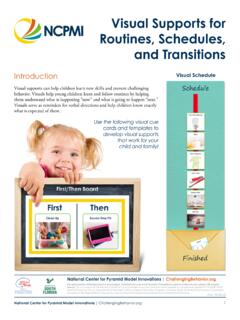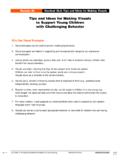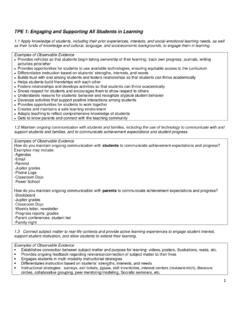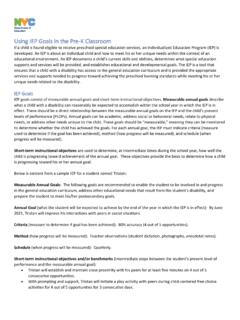Visual Supports For Routines Schedules And Transitions
Found 9 free book(s)Using Visual Supports with Infants and Toddlers
www.ctdinstitute.orgTypes of visual supports 3-8 Example: Transitions 9 Tips for making visual supports 10 Implementation of visual supports 10 ... routines. Visual supports provide supplemental information, cues, and ... Visual schedules lay out the events of a day or routine
Stages of Behavior Escalation for Individuals with Autism ...
www.lehsd.orgUse visual supports for transitions, expressing needs, teaching rules and expectations, etc. ... o Disruption of schedules and routines or “surprises” o New unfamiliar tasks, people, place, etc. ... Inconsistency in schedules can cause some individuals …
Autism Spectrum Disorder (DSM 5.0) – Clinician Version
med.stanford.eduOct 08, 2013 · supports in place, functional impairments are apparent; limited initiation of social ... • Difficulties with transitions • Examples of routines: schedules, eating, object placement, dressing, driving routes, greetings ... • Visual examination of …
Including Children with Challenging Behavior in the ...
rwjms.rutgers.eduTransitions, Cues, Prompts, Supports, Accommodations… Schedules, Room ... Adaptations, Resources, Predictability… Routines, Resources, Siblings, Environment, Respite, Predictability, Extended family… Places family goes, Activities… Shared interests & ... This is a visual representation of the A-B-C of behavior and categories we ...
Visual Supports for Routines, Schedules, and Transitions
challengingbehavior.cbcs.usf.eduSep 30, 2020 · Visual Supports for outines, Schedules, and Transitions ChallengingBehavior.org | National Center for Pyramid Model Innovations 2 Visual Schedules Using a visual schedule at home provides young children with predictability (i.e., they know what activity or routine
Tips and Ideas for Making Visuals to Support Young ...
csefel.vanderbilt.edu6. Regular routines, when represented visually, can be taught to children at a very young age. Once taught, the adult can fade out of the routine and allow the child to self-monitor the routine to completion. 7. For many children, visual supports are most beneficial when used in conjunction with spoken language and/or sign language. 8.
TPE 1: Engaging and Supporting All Students in Learning
www.esgvrop.orgDevelops daily schedules to maximize learning Adapts routines, procedures, and norms to ensure success of all students Models fairness and respect Respects and is aware of cultural diversity and learning abilities in the make-up of the class Responds to inappropriate behavior consistently Maintains routines
Using IEP Goals in the Pre-K Classroom
infohub.nyced.org• Provide extra structure and support during transitions (visual and verbal cues, individual schedule, songs) • Provide a peer to help model appropriate behaviors • Follow a specific and consistent routine • Alternate quiet and active tasks • Allow for breaks as need (cozy/quiet area) • Model coping strategies to label and deal with ...
UDL Guidelines Checklist
wvde.state.wv.usUDL Guidelines Checklist Principle I. Provide Multiple Means of Representation Guideline 1: Provide options for perception Checkpoint 1.1 – Offer ways of customizing the display of information: Display information in a flexible format so that …








